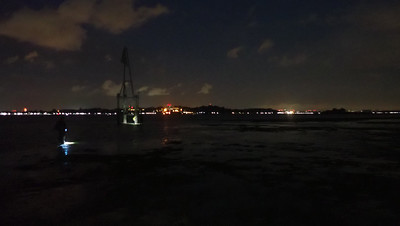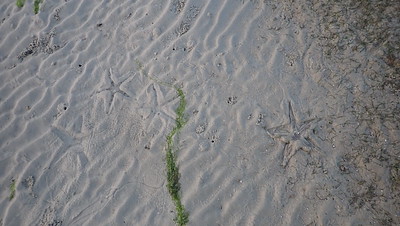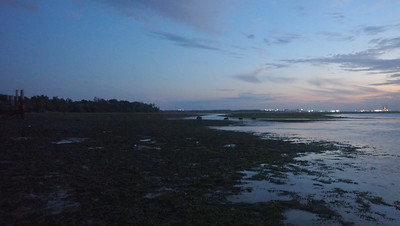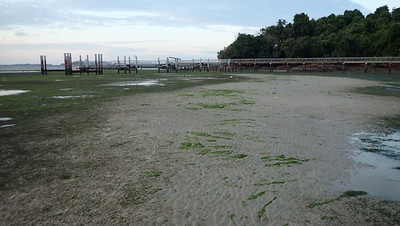A small team completes our annual survey of Chek Jawa's southern shore.
Unfortunately, the tide wasn't as low as we would have liked it, so we
couldn't really confirm if the coral rubble area is as rich as it was at our
last survey in Jul 2019.
But we were thrilled to see that the Common sea stars appear to be making a
comeback to Chek Jawa. They were wiped out in the devastating mass deaths in 2007 which also wiped out the sponges and many other animals here. Chek Jawa
was also hit by the 300-tonne oil spill in the East Johor Strait in Jan 2017.
Echinoderms are still abundant on this shore. I saw Knobbly sea stars large and small, Biscuit sea stars medium to small, and some Sand stars, while the rest of the team saw other kinds of sea stars too. There were also Synaptid sea cucumbers draped on sponges, many small Garlic bread sea cucumbers and and many Ball sea cucumbers buried in the sandy areas. As usual, there were only a few Thorny and Pink warty sea cucumbers - not as abundantly as seen on Changi. I also saw several white sea urchins at the beacon area, and a skeleton of a Keeled heart urchin. As usual, we start surveying from the jetty at House No. 1. The legs are still well encrusted in ascidians and sponges. Which are eaten by flatworms. There are also cowrie snails and lots of little crabs.
I checked a short part of the shore west of House No. 1 opposite Pulau Sekudu. Zoanthids have covered large areas, sprinkled with ascidians and encrusting sponges. Including some very large Blob ascidians.
The sand bar east of House No. 1 is now densely covered with seagrasses and dotted with lots and lots of Haddon's carpet anemones. There were also many Swimming anemones everywhere.
I also came across many cerianthids and a few sea pens of various kinds.
Unfortunately, the tide wasn't low enough to see the edges of the sand bar. It was windy and the water was murky and I couldn't see much here. But I did see a few common sponges. And glimpses through the water of some Barrel sponges and a few sea fans (no photos though). I saw some Flowery soft corals, and 6 Boulder pore corals that were a nice healthy brown.
At the beacon, a nice surprise to see a Ramose murex. This large snail is listed as 'Endangered' on our Red List of threatened animals. Hopefully, it will find a safe home on Chek Jawa and produce lots of young to settle in the shores around.
Quietly in the dark, there were many Wild boar foraging on the shore. Seems mostly mama boar with piglets.
The southern sand bar that used to be at the end of the pontoon area of the boardwalk has shifted!
There is now a stream that separates the pontoon area and a sand bar further east.
And another smaller sand bar closer to the boardwalk itself. This is where we saw the Common sea stars. I did not see any signs during the survey of the mussels that had taken over some parts of Changi.
Similar to what I observed on our last survey here in Jul 2019, Smooth ribbon seagrasses are doing very well. They have taken over a large portion of the area between the beacon and the boardwalk. There were also dense growths of Needle seagrass with broad leaves. It was good to see lots of Fern seagrass as well. Today we did not come across any fresh nets or traps along our survey route. Hurray! I only came across one dugong feeding trail near House No. 1. Kok Sheng shared this photo of a dugong feeding trail too.
One of the treats of a predawn survey is a glorious sunrise! With the mountains of Penggerang in Johor on the horizon.
Thanks to NParks for permission to do these predawn low spring tide surveys of Chek Jawa. Thanks also to Chay Hoon for making all the transport arrangements. And the team for helping to cover as much ground as we can during the narrow low tide window. Thank you!
What is the fate of Chek Jawa?
Chek Jawa and Pulau Sekudu may be affected by the 2030 landuse plan by the Ministry of National Development. The plan includes plans for a road link (black line) from the mainland jumping off at Punggol, crossing to Pulau Ubin through Chek Jawa to jump off to Pulau Tekong before circling back to the mainland on Changi East. Proposed reclamation (in yellow) will bury Pasir Ris shores, Pulau Sekudu and Chek Jawa as well as a large amount of shore at Changi Beach. I feel it is thus important to update our understanding of what is going on in the field at these sites including Chek Jawa and Pulau Sekudu.
The Singapore Blue Plan 2018
Among the Proposed Areas for Immediate Conservation Priority, the Singapore Blue Plan 2018 proposes that the intertidal and subtidal marine areas of Pulau Ubin to be designated Marine Reserve.
The proposed area would include Tanjung Chek Jawa, the largest known intertidal area in northern Singapore. Considered one of the richest in Singapore, Chek Jawa comprises many adjacent ecosystems: coastal hill forest, mangrove areas, rocky shores, seagrass meadows, coral communities, and sandy areas. Chek Jawa remains an icon of celebration and hope for many Singaporeans since its reprieve from reclamation in 2001.
Much of the remaining coastal areas around Pulau Ubin are mangrove areas. Protecting these can be impactful due to the relatively large interconnected areas. Already, a community-driven project, Restore Ubin Mangroves (R.U.M.) Initiative, is in place to rehabilitate mangrove areas previously converted to fish and shrimp farms. These areas also offer hope for the recovery of the smallclawed otter population.
DOWNLOAD the Plan, SUPPORT the Plan! More on the Singapore Blue Plan 2018 site.
Among the Proposed Areas for Immediate Conservation Priority, the Singapore Blue Plan 2018 proposes that the intertidal and subtidal marine areas of Pulau Ubin to be designated Marine Reserve.
The proposed area would include Tanjung Chek Jawa, the largest known intertidal area in northern Singapore. Considered one of the richest in Singapore, Chek Jawa comprises many adjacent ecosystems: coastal hill forest, mangrove areas, rocky shores, seagrass meadows, coral communities, and sandy areas. Chek Jawa remains an icon of celebration and hope for many Singaporeans since its reprieve from reclamation in 2001.
Much of the remaining coastal areas around Pulau Ubin are mangrove areas. Protecting these can be impactful due to the relatively large interconnected areas. Already, a community-driven project, Restore Ubin Mangroves (R.U.M.) Initiative, is in place to rehabilitate mangrove areas previously converted to fish and shrimp farms. These areas also offer hope for the recovery of the smallclawed otter population.
DOWNLOAD the Plan, SUPPORT the Plan! More on the Singapore Blue Plan 2018 site.
Photos by others on this survey
Jianlin Liu
Loh Kok Sheng
Vincent Choo
Toh Chay Hoon

















